On HL2: Episode Two, linearity, the G-Man, and Episode Three
By zanzibarbreeze 19 Comments
Having reached the end of my Half-Life 2 experience, pending now only the release of Episode Three, I can authoritatively say this: I enjoyed everything that I played, especially Half-Life 2, but I am surprising myself (though perhaps not you, dear reader) when I say that I enjoyed Half-Life 2: Episode Two the most of the three games. The reason why I find that surprising is that, in the lens through which I perceive video games (which is, admittedly, a lens still firmly entrenched in the era spanning 1996 to 2004) what amounts to an expansion pack or a side-mission for a video game should never really have the chops to outdo the original, which is what Episode Two manages, with colors that fly so high that they have propelled themselves into the exosphere. So, in that very longwinded spiel, and in the not-so longwinded but admittedly long text that follows, I am saying what amounts to this: Half-Life 2: Episode Two is better than Half-Life 2, even though it is less than half the length of Half-Life 2. Also, I cannot suppress the anxiety that raps through me when I consider that I am still awaiting Episode Three.
The following is organized as per my other few posts that I have so far amounted. I discuss points I think significant with regards to Episode Two’s design, graphics and animation, gameplay, and story, before giving my own impressions of some parts of the game, impressions which didn’t quite seem to fit under the preceding four limbs. Because I think there is much of interest to discuss with regards to Episode Two I’ve included three brief essays (or rather three brief collections of thoughts) about linearity in Half-Life 2, the G-Man cutscene in Episode Two, and, finally, where I think Episode Three will go and where I would like Episode Three to go from the conclusion of Episode Two.
Please note, for your own welfare, that Episode Two probably still contains some very spoiler-worthy moments which I refer to liberally all over the post. It has been three years since release, but doubtless there are still people who are waiting to play the Half-Life 2 arc until just before the release of Episode Three. I cannot account for those individuals and as such I have decided not to mark spoilers. I beg that you read at your own discretion.
Episode Two preserves many of the finer points of Half-Life 2 and Episode One . Because I have already posted blogs about Half-Life 2 and Episode One, I won’t repeat those common points unless they seem particularly salient or unless Episode Two built upon or amended those commonalities. I have instead placed much revised versions of the original points in spoiler tags, but I encourage you to glance at the original texts if you are so inclined.
A note on the PlayStation 3
All my playthroughs of Half-Life 2: Episode Two have been on the PlayStation 3. Two criticisms could be leveled here: firstly, Episode Two was designed to be played on a personal computer. It was not designed for consoles. Interestingly, some parts of the game work better on consoles, but there are clearly some detriments. Primarily, aiming with joysticks is plainly not as precise as aiming with a mouse. There are other things which work in the consoles’ favor: take, for instance, the fact that platforming is reportedly less painful on consoles.Secondly, much has been made of the fact that the PlayStation 3, though still the complete Episode Two experience, bears the worst version of Episode Two. Perhaps this is in fact the case, but I personally find no real fault with this particular edition. Attribute this to the fact that I have played no other version; ultimately, though, I’ve experienced none of the major problems that critics have cited. Loading, for instance, is not as distressing as others would have you believe. Neither did I experience any frame-rate issues whatsoever in this particular instance of playing the game. In comparison with the majority of other PlayStation 3 games, Episode Two plays proficiently and without tumult. Make of these points what you will, but I note that with those who try to claim that the PlayStation 3 version of this game is somehow unplayable or offensive, if there are such people, are incorrect.
Design
There are now large areas without load breaks
All my experience with Valve has seen games with short areas and game-stopping load breaks bridging those areas together. It’s never particularly bothered me but it is nice to see that in Episode Two Valve managed to build considerably large areas without load breaks segmenting them into smaller, more manageable chunks. I was particularly impressed with the Antlion caves, but more so impressed with the roads up to White Forest (the house, for instance) and the large, ‘open world’ arena in which the Strider fight takes place at the end of the game. Other shooters which load areas by streaming negate this praise, but the fact that Valve managed to make some gains over their previous shooters in the Half-Life franchise is, I think, worth noting.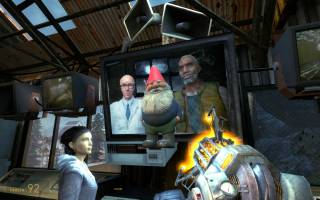
Excellent environmental design
There’s nothing quite like Valve’s sound design. Sound acts as an auger for elements bearing down on the player. Everything has its own unique, distinct sound. But Valve’s ability to design environments -- not level design, but environments -- has also increased in leaps and bounds over what is evidenced in previous Half-Life 2 games. An excellent example of this is the early sequences of Episode Two, particularly moments before Alyx dies. The player is well aware that there’s a Hunter in the area: he’s seen it and he’s heard it, and he recalls what it looks like from Episode One, but there’s nothing he can do about it because he’s got no weapons and he’s never seen it in the flesh and he’s utterly powerless. Moreover, the player doesn’t want to fight it. Nobody wants to fight Hunters, but that’s all due to the brilliant design.Choice
Half-Life 2: Episode Two gives the player much more choice than previous games in the franchise. There are several moments in the game where the player can choose to bypass large battles and continue on the path to White Forest. There is, for example, the large dual-house fight after the encounter with the Advisor. One can hang around and clear both houses, or one can just get in the car and keep motoring on. It’s a nice example of weighing up the consequences: ‘I can have fun figuring out how to survive this’, or alternatively, ‘I don’t have enough health and I don’t have enough ammunition and I need to go’. It’s also a more realistic look at how people cope with situations like this: in real life, most individuals would flee when they’re a team of two armed people versus twenty armed soldiers plus four robots that attack the player and that are called specifically called “Hunters”.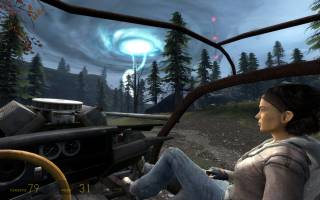
Great co-op partners
If I was to do a survey of all the games this generation that had AI controlled co-op characters, I think that by-in-large I’d find that it’s apparently very hard to successfully integrate AI buddies into a game. Valve showed with Episode One that it could manage very well, but it’s managed to build upon that effort in Episode Two. Running with a computer buddy in Episode Two is an absolute joy. In too many games AI characters provide only irritation; in Episode Two Alyx and the Vortigaunt are not only legitimately helpful, but also fun to run with. They provide assistance in cases where the player needs it -- the Vortigaunt, for instance, is good at eliminating the acid-spitting antlions; Alyx will provide cover for the player while he’s trying to solve the puzzles on the road to White Forest -- and they’ll also let the player in on what’s on their mind. Importantly, however, it’s always praise. No player wants to be nagged at by a buddy. There’s all of that in most other games, and there’s none of that in Episode Two, which is truly a breath of fresh air.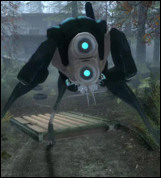
The Hunter is a great enemy
Here’s what’s great about the Hunter: while the Combine still may not have the sprightliest artificial intelligence in the world, the Hunter makes up for them completely. The Hunter is a tremendous threat -- it’s aggressive, it’s fast, it’s dangerous, it’s cruel, and it’s brutal, and above all, the player will never be satisfied with their approach to dealing with the Hunter. It’s amazing that there is an enemy where, on foot, one can never be happy with one’s ability to destroy it, even by the end of the game. There aren’t really any weapons that are instantly effective at dismantling a Hunter. The magnum takes at least a full clip to dispatch a Hunter; three rockets are required from the rocket launcher. The Pulse rifle’s energy ball is a fine approach, but that ammunition is scant in Episode Two. In actuality, the best way to eliminate a Hunter is to run it over using a car, but on foot, the Hunter is a worthy adversary, and I love the way the beast was designed by Valve. Another thing that’s also horrifying: the Hunter comes into buildings and moves between rooms, no matter how big or small. It’s simply a great enemy.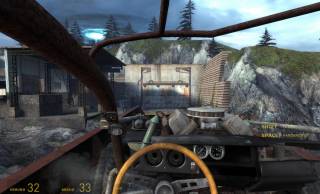
The driving is much better handled than in Half-Life 2
While it didn’t seem to me that the actual driving mechanic has improved over Half-Life 2, the environments in which the player is required to drive have most definitely improved in the sense that there are no longer any tight roads or turns, and there aren’t any random obstructions on the path. As a result the driving is much less bothersome and much simpler, and cruising through the forest environment is fairly enjoyable.‘Sector Sweep’ is Kelly Bailey’s best work
Kelly Bailey is the chief sound design engineer at Valve. Prior to Episode Two, he was responsible for all the music for the Valve-developed Half-Life franchise. The music in this franchise has never really been prominent. It’s almost always in the background, ambient, and it never really pipes up to contribute to the action as a whole. Of course, there’s nothing wrong or nothing lacking with regards to that, because music can serve different purposes. However, Sector Sweep, the song that plays after the contact with the Advisor in the basement, is Bailey’s best work. It’s loud, it’s heavy, it’s violent, and it’s good, and it totally heightens this portion of the game with the Combine fight and lends the fight much more feeling and tension.The “Previously on...” sequence was handled well
This is by no means the most significant part of Episode Two, but I feel it’s worth mentioning, because it certainly impressed me enough to jot down a quick note. The introduction segment to Episode Two, which essentially covers the story so far, is nicely cut. It’s upbeat, well timed, well compiled, and it’s great to watch even if one knows all the inner workings of the Half-Life 2 narrative.Graphics and Animation
Character animation is superb
Episode One iterated over Half-Life 2 with regards to how characters animated, and Episode Two iterates similarly over Episode One. In Episode One, characters mostly stood around talking and did very little moving while talking. This has been completely overhauled in Episode Two. Characters now move independently of the player. That might sound a little trite, but consider that in Half-Life 2 non-player characters seemed to be anchored to the player. They can now move independently of the player without first checking their position as per what the player is doing. Also, non-player characters are much livelier. Their gestures and hand movements are now very relevant and add an extra layer of expression on top of facial expressions and the script. Indeed, paying full attention to a character while the character is talking is now instrumental to understanding that character’s message, whereas in Half-Life 2 or Episode One the player could get by with staying within earshot and listening only to the speech. Episode Two is fantastically immersive.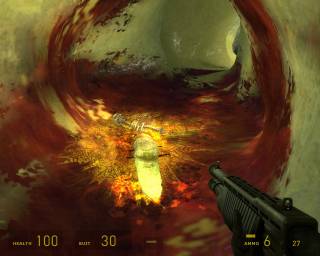
The antlion caves look spectacular
I’m very fond of the aesthetic of the antlion caves. Valve has featured plenty of dark areas in the past, but the antlion caves manage to be both dark and well lit, if that makes any sense. I was particularly impressed by the larvae nests, the yellow, webby, sticky, funky look. These areas as a whole are very convincing and are very soft on the eyes and, in a way, it unintentionally contrasts with the forest areas of the game which, from a 2010 perspective, are starting to look a little rough. By contrast the antlion caves could be a contemporary compostion. It’s particularly so with the very yellow parts of the cave where the giant larvae nests are (during the chase/fight with the Guardian). The scope of the area is very impressive and the textures are impeccable.No Vaseline
Whenever we refer to Vaseline in graphics, the instant picture in our minds is of very early games from this generation, even up to 2008, where a lot of the textures and even some of the characters appeared to be shiny, and the screen and the atmosphere appeared to be slightly blurry or foggy -- in other words, the Vaseline effect, as if the world had been smeared in Vaseline. It was an interesting effect earlier in the generation but one that has been much discredited over the last few years. It’s heartening to see that Valve did not succumb to this, especially with the rocky, craggy environments in Episode Two. To be sure, there is a little shine in the antlion caves, but it feels natural, and it isn’t present anywhere where it would be inappropriate.Facial animation is brilliant
The facial animation in Episode Two is still ahead of its time. Improvements over Half-Life 2 are less noticeable than improvements in body animation because Half-Life 2’s facial animation was astounding to begin with. If anything, the expressions haven’t changed all that much, but the way they transition and animate with regards to the body is much more convincing.Gameplay
Significantly better AI over Half-Life 2 and Episode One
I’ve previously made much of the fact that the artificial intelligence for enemies in Half-Life 2 and in Episode One was rather terrible, but the AI in Episode Two is much more credible. The Combine troops now seem to work together in groups when assailing the player. No longer do they rush, and if they do, it’s very infrequent. Hostiles also seem more inclined to move behind cover, or just move around, as in move back or shuffle to the side, when they’re under attack. They also pose a significant threat, especially in areas like the house on the road to White Forest where they enter the building and clear from room to room.Episode Two straddles the line between being a shooter and an ‘action-adventure’ game
What is Episode Two? I’m not quite sure. There’s always been the argument that because the shooting in the Half-Life series has not been in the top tier, and because the Half-Life series has been so focused on puzzles and navigating environments, that Half-Life is more an ‘action-adventure’ game (whatever ‘action-adventure’ means) than a shooter. Episode Two positively straddles the line between the two, because the shooting has gotten better (as we’ll mention below), but also because Episode Two places much more emphasis on good, positive combat and shooting than it does on puzzles, the most of which are now out of the way and optional, or much simpler and less gravity- or physics-based. I personally am inclined to refer to Episode Two as a shooter, just as I have always been inclined to describe the Half-Life franchise as a shooter series.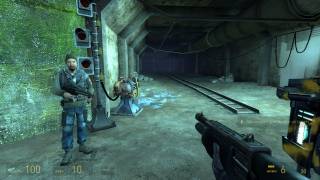
The shooting has increased in quality over Half-Life 2 and Episode One
As in the above, the shooting in Episode Two is much better than in previous installments in the series. It’s much more accurate and it feels like the weapons have weight and punch, and their presence in the world registers. It’s important that the quality of the shooting increases exponentially alongside the quality of the enemy AI. Obviously as the threat posed by hostiles increases the need to be precise and accurate increases also. Valve did well with Episode Two.A previous weapon button would be useful
It suddenly struck me in the early stages of playing through Episode Two that a previous weapon button would be convenient to have; in other words, a key that swaps the weapon Freeman is holding for the previous non-gravity gun weapon Freeman was holding. I assume there is such a button on the PC version of the game, and I assume that the reason such a button wasn’t included for the consoles was because there aren’t an infinite (or at least exorbitant) number of keys on the controller. There’s no quick or easy way to select weapons that are on the extreme left or right of the menu on the console version of the game (for those who don’t know, the weapons are organized as something of a wagon wheel on the directional pad, and to select the Pulse rifle, for instance, one has to press right three times; for the magnum it’s up three times -- obviously this takes longer than a quick selection and can make the difference between losing some health and hemorrhaging health in areas packed with aggressive enemies). Having an ability to instantly swap weapons would go a long way.The weapons come in quickly
Episode One took a long time to introduce weapons to the player, and by the time the full palette was featured the game had ended. This is not so in Episode Two. The shotgun and handgun are made available near instantly and the other weapons are distributed much more easily and evenly throughout the game than in Episode One. Moreover, the weapons are introduced during periods of time where it makes sense. The only weapon that is perhaps a little out of place is the rocket launcher. It’s never really needed in the game as a whole.No stupid puzzles or tasks
How nice it is to not have to drive a boat across pipes, or not to have to catch giant pieces of falling rubble using the gravity gun! Half-Life 2: Episode Two features no stupid puzzles or tasks, unlike the games in the franchise preceding it. Many of the puzzles come in at late stages in the game and are optional and very interesting. One of my favorite puzzles is one that must be completed for the rocket launcher lambda cache to be accessed. I recall during my first playthrough of the game that I spent approximately thirty minutes in that room trying to find the solution, convinced that it had nothing to do with the cache of grenades in the corner (I should have known better). I even brought in objects from outside to try and climb up to the platform as opposed solving the puzzle via the proper method. Then it finally clicked that what I had to do was slide a grenade under the pop-up platform and allow myself to be propelled up. It was glorious. Puzzles like that are very entertaining and rewarding. I appreciate the fact that Valve included several puzzles which are totally optional, but which are mostly entertaining. For those who don’t want to stop and just want to keep going, they can, but for those who do want to stop and experience the game fully, the puzzles beckon.The zombies are abusive
Here’s something that I found very disturbing: the zombies in Episode Two are abusive. Zombies now throw environmental objects at the player, and they pose a very valid and fierce threat. They are dangerous, and it hurts when one gets hit in the face by barrels and crates. Gordon reels back, the screen shakes; there are alarmingly loud sounds -- bones breaking and a distinct shattering. It hurts psychologically as well, which is why I call the zombies “abusive”. Why does the game have to be so cruel? Any predisposed fondness for zombies you may have will disappear upon playing this game, assuming you, my reader, have not played this game yet, because the zombies are jerks, and it is brilliant. It makes fighting with these previously placid hostiles much more engaging.
Travelocity
There is an achievement in the XBOX 360 version of Episode Two that requires the player to take the garden gnome (that looks like the Travelocity gnome) from the first little hut at the very beginning of the game and carry the gnome across the world to Magnusson’s rocket at the very end, where the player must deposit the gnome in the rocket before heading to the underground chambers of White Forest. I have not attempted this, but I like the idea. Apparently it’s very difficult and very frustrating, but I imagine that it’s also somewhat rewarding. I find that quirky tasks like this are much more charming and appealing than, say, collecting collectibles scattered throughout the world.Innovative achievements
Linking with the Travelocity gnome are the interesting achievements that The Orange Box package is endowed with. I recognize the value of achievements which cause the player to think about the way they play the game, and which cause the player to play the game using different methods. Here are some unique achievements:- Kill five enemies with a Manhack.
- Kill a Combine soldier with his own grenade.
- Use flares to light 15 zombies on fire.
- Kill five barnacles with one barrel.
- Send the garden gnome into space.
- Kill a Hunter with its own flechettes.
Story
Even I can appreciate the blatant Black Mesa/White Forest parallels
Speaking personally, I find narratives that beat you over the head with explicitly obvious information infinitely less appealing than subtler storytelling. The parallel between Black Mesa and White Forest is quite blatant and over-nourished, but even so, I think it’s nicely handled. For those that may not have realized, here are a few draws: the name Black Mesa is obviously comprised of the word Black, which is the darkest color known to man, and the word Mesa, which is a flat, clear, barren, elevated plain defined by sharp cliffs at its edges; whereas the name White Forest is comprised of the word White, which is the lightest color known to man and not dark, and the word Forest, which in ordinary usage implies a very hilly, rough landscape, exceedingly pockmarked with trees. Then there are the functional similarities: both the Black Mesa and White Forest facilities are scientific, and serve as the testing grounds for new technology. In both facilities the player descends deep into the ground and up above the surface. There are many more, and one could go on, but those are the more superficial similarities.Amazing G-Man speech
I actually want to discuss this with more detail in the section below, but it’s worth a very brief mention here. This G-Man cutscene is amazingly good, and I can’t refrain from watching it over and over and over again.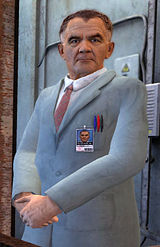
I love Dr. Magnusson
Good stories have good characters; Dr. Magnusson is not just a good character, he is a superb character. I adore Dr. Magnusson. I can boil it down to his traits. My favorite thing about him is his inability to thank or praise others. He’s brilliantly written and more than funny. There’s nothing more amusing than Magnusson mocking Eli, Alyx, and Gordon for having a “family reunion”, or Magnusson putting the destruction of the Striders down to his aptly named ‘Magnusson Device’ as opposed to Gordon’s deployment of said device (in fact, he’s probably right, because those Striders basically do “just destroy themselves”). Magnusson also parallels very nicely with Alyx. Whereas Alyx is patient with the player, Magnusson is not, and he’ll even follow and beleaguer the player over the facility’s intercom, and criticize and nag when things aren’t going quite to his pace or when things aren’t going so well. It sounds like it could be irritating, but in reality it’s rather comic. Valve have found a way to nag funny, which is a concerning breakthrough in the world of video games. Some pearls of wisdom from the Magnusson:If I'm right about this -- and I have no reason to doubt myself -- you are carrying the very code Doctor Mossman had hoped to recover!
Oh -- oh, excuse me if I'm interrupting tea time! I'll just step out until you've finished, if that's more convenient!
Observations
Pins and needles (To the White Forest)
I rarely respond to media, but there were several moments in Episode Two when I had the pins and needles going, and the death of Alyx is a prime example. I don’t know quite why I got effected at this stage: I can only surmise that it’s because I like the character Alyx and don’t want the character Alyx to die, because, in all honesty, I think that this scene is handled rather poorly, and I know what the problem is: it’s the first person perspective, and the fact that the player is trapped and can’t move. It’s extremely dissatisfying being frozen and not being able to move and not being able to properly see what’s going on. If the way that scene is handled doesn’t lead to the impact, then the reason why it can elect a response is because of the character being hurt. I think that’s a strong indication of Valve’s ability to build character, that they can especially do so when not in the best of circumstances.
Stepping on grubs (This Vortal Coil)
There’s a strange moment when the player first emerges from the first antlion caves into the large arena with the two men and the Vortigaunt and Alyx. Yellow antlion larvae are dispersed throughout the caves. Step on them and they perish. When the player exits into the room, one of the men there says that stepping on the antlion grubs will summon more antlions. As it turns out, that’s not actually true, but I don’t understand why that line was included. It only serves to strike doubt into the player, and it seems a little off-key. I felt like I was responsible for everything antlion-related that had happened hitherto, when that’s simply not the case.The vortigaunt is a great co-op partner (This Vortal Coil)
I love blasting through the caves with the vortigaunt. He’s a simple character to grow to because of the writing. I adore the way he words praise, and the constant praise and constant amazement at what Gordon Freeman can do.The cog puzzle is a little silly (This Vortal Coil)
It’s true that there are no stupid or bad puzzles in Episode Two, but those two words do not discount silly puzzles, which is what this cog puzzle is. It essentially involves having the player find a cog somewhere in a room and attach said cog to where a bunch of other cogs and levers are. It’s just a bit pointless; it’s essentially a hunt puzzle. The only legitimate part of it is finding one’s way around the barnacles. It’s funny to see the cog placed in the machine only for it to be spirited away by upwards by a barnacle. Then panic ensues and the player throws everything they have at that one barnacle. It’s nice to see that Valve can elect such fury through the use of rather mild-mannered enemies.“Be adequate.” (This Vortal Coil)
Nobody even knows what this means, but it’s a great line. If I had the balls I would use it in real life. “Be adequate.” What the hell does that even mean? “I don’t know, it sounds like something the vortigaunts would say.” Be adequate, Gordon. Be adequate.The bridge physics puzzle is a little silly (Freeman Pontifex)
This is a strange puzzle, and it’s strange because it doesn’t really make sense with regards to the physics in the world. In theory, removing all the cars on a broken piece of bridge wouldn’t cause the bridge to lean to one side as if it was weighted. The bridge should, in actuality, be level. If anything the puzzle is unfair. Very few people would immediately click that the solution to the puzzle is to knock all the cars off the bridge, because it’s such cognitive dissonance with regards to the physics in the world. I recall that I got stuck at this portion during my first playthrough some time ago, because I didn’t think that would be the solution, especially after being so well trained to use the game’s physics beforehand. The best part of the bridge is actually the hut to the side. The small hut is dark, and the player knows that he shouldn’t go in there, but he does, and he dies. It’s a nice example of the game punishing the player for going somewhere they absolutely know they shouldn’t, and it’s cool.The Hunter fight is really cool (Riding Shotgun)
This is dependent on the Hunters being really great enemies, which they are. As a whole, though, the Hunter fight is very nicely done. What’s especially effective about it is the decision to trap the player and Alyx in what is a relatively small room (at least for the early stages of the battle). There’s not a whole lot of space to move around in, and against the Hunter -- a very aggressive enemy, perhaps mostly famed for its ability to kick and impart pain -- the situation feels very life threatening.Dog vs. Strider (Under the Radar)
With regards to good animation, the Dog vs. Strider battle is a good example of something that’s entertaining to watch and that captivates, even though the player has nothing to do with it. As the player, I even felt a little vulnerable throughout. But it’s a well handled sequence. It could have gone horribly, horribly wrong, but it didn’t.
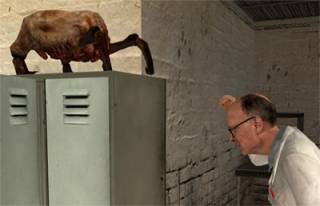
Poor Lamarr (Our Mutual Fiend)
Some people like to put Lamarr in the rocket and lock the hatch so that Lamarr gets blasted off into space. Poor Lamarr! Poor, poor Lamarr! He just wants to be happy.The attention to detail in White Forest is impeccable (Our Mutual Fiend)
It’s worth briefly praising the attention to detail in White Forest. The detail makes the place look really used and lived-in and populated. There is, for example, the whiteboard which shows the player the thinking behind the Magnusson device, the taped-together nature of the site, and the microwave with Magnusson’s lunch. Overall, it’s really nice, caring design.The end (T-Minus One)
I find that the ending to Episode Two is still shocking and distressing, even after having seen it multiple times. Again, it’s not so much that the scene is handled particularly well. It’s more down to the acting in this case, in particular the voice acting both from Eli and especially from Alyx. The way she weeps after the fade to black is truly upsetting.
I now want to move away from discussing individual aspects of the game and addressing some wider themes that are worth some talk.
Welcome to the open world
One of the impressions that Half-Life 2: Episode Two imparts, whether a false impression or one that is justified, is that Valve is looking to break with the strictly linear approach they have taken to the Half-Life franchise (where there is only one way forward and the player is blocked or actively discouraged to retread their footsteps) and is looking to extend the world to where there are many more options and many different approaches the player can take in addressing a situation. I constructed this impression by looking at two different aspects of Episode Two. Firstly, the levels as a whole are now much grander in scope than before. In employing the term ‘levels’ I’m specifically referring to the way the game approaches areas, that is, each area that the game has to stop and load. As I mentioned above, I was impressed by how big each level is, especially the sections around White Forest, and I was impressed by how few loading breaks there were compared to Half-Life 2. Secondly, with reference to White Forest, I found it interesting how open the last sequence was. There were several different roads and paths to take to head from one building to another and the player can stand before Striders or ring around them. The area is massive, and open.Linearity is one of the things about the Half-Life franchise that really jumps out at a player that’s paying attention. Linearity in other games is an excessively negative term. One of the main critiques of Final Fantasy XIII (and indeed Final Fantasy X before it) was that it was very linear, and that the player was holding up on the analog stick the majority of the time. And yet, shooters, particularly first-person shooters like Halo, Half-Life, and Killzone, tend to be exceedingly more linear than other games, and are not particularly lambasted for it. It was from these games that the term ‘corridor shooter’ emerged, because even if the world was faux-open, the player was really only running and gunning down a corridor. And what does linearity mean for racing games, where the whole goal is to drive around the same course five or six times, always going forward, and always retracing the same ground?
Ultimately, it’s rather unsettling to note that all games are linear, even ‘open world’ games. There is always a natural progression of where the player must go and what the player must do. The most traditional example of an open world game would be the Grand Theft Auto franchise, but even there, although the player can play in a sandbox, they must proceed down a very linear, very structured path to complete the game. They have to complete missions for a number of different non-player characters before they can quell what has been motivating them and defeat the final boss. The world and the levels may be open, but the game is anything but open. The game will always be linear. There’s something to be said about pretending not to be linear, however. That’s what games like Grand Theft Auto do, and with regards to racing, that’s what games like Burnout Paradise do -- even though the player will always have to head in the same direction and head to one destination, he can take any number of finite routes to get to that destination. Thinking about that, it’s interesting to consider whether Valve was trying to adopt a similar, Burnout Paradise-like approach.
Linearity bears its comforting qualities for both game developers and game players. For developers, designing a linear course for players to walk and shoot through is far less difficult than designing a less linear, more open shooting gallery. But for players, linearity also brings that feeling of assuredness. There’s that feeling of no matter what, all that is ever required of one is to move forward and move to the next objective. The player won’t have to backtrack across old ground just to get a new weapon; the player won’t have to backtrack across old ground just to unlock another door and press a button on a computer console; the player won’t miss anything behind him and he won’t have to worry about exploring every single different path because there’s nothing of note down ninety percent of them in any case.
Linearity is Valve’s bread, and linearity is Valve’s butter. Was Valve trying to splinter (but not break) the mold with Episode Two? If they were, they managed it in a way that was easy to appreciate. If there is a spectrum of linearity, where at one end there is extreme linearity and at the other end there is extreme ‘open world-pseudo linearity’, then Episode Two sits somewhere in the middle, but closer to linearity than to open world-ness. Episode Two is a very satisfying linear experience that offers different paths, but ultimately paths that all lead to the same final destination.
As much as Half-Life is linear, it must be said that linearity is not a base quality of Half-Life. The base qualities of Half-Life come down to shooting, progressing through environments, and solving puzzles. Linearity is a non-essential quality. That’s not to say that Episode Two indicates that Valve will eschew linearity for Episode Three or for Half-Life 3. The allure of linearity is too much to resist for both players and developers alike. Despite that fact, moving away from isolating the player in corridors provides different results. Valve tested the waters with the conclusion to Episode Two, and it’s up to them to divine what comes from it.
“Dr. Freeman...”
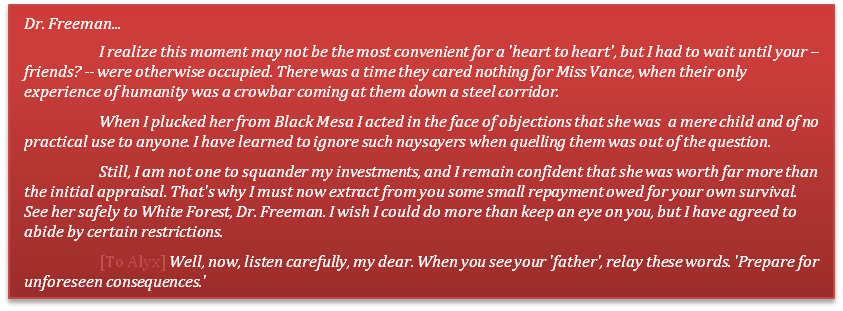
This scene is without question my favorite cutscene of the Half-Life franchise, and one of my favorite cutscenes across all video games. There are a few simple reasons for this standing, but I think it pertinent to briefly address some points I find interesting about the scene and some things that I think are probably worth noting.
I like the fact that Valve spends a long time establishing that the player will never lose control of Gordon Freeman, even throughout most scenes of exposition, only for Valve to then disrupt this quality during the times when the G-Man appears. This has some significance, obviously. It has primarily to do with the fact that the player is now watching a cutscene as opposed to listening to exposition. Cutscenes have instructive qualities in video games, because it’s a time when the player typically has very little control. The player is essentially told to set down the controller and watch and listen, which, as aforementioned, is the antithesis of the traditional Half-Life approach to communicating story and narrative. This scene is very clearly a cutscene, for it features things that could never happen in the ‘reality’ of the ‘Half-Life world’. It jumps to the past in a setting from Black Mesa, and then it jumps to the future to a setting from White Forest (another Black Mesa/White Forest parallel), and in between it features the indoor urban setting from Dr. Mossman’s transmission, a still of men falling to the ground and blood spraying out from their bodies. Then there are the more obvious signs that this is a break from ‘reality’ -- the holographic, transparent G-Man, for instance. These things all have natural implications on the character of Gordon Freeman. It’s a long running joke that Gordon Freeman is not actually a ‘free’ man, for he is largely being controlled by the G-Man. This scene serves as a fine indication of that. Not only is Freeman not a free man, but it’s also made abundantly clear that this is not Gordon Freeman’s game, and neither, by proxy, is it the player’s game: it’s the G-Man’s game.
The fact that the G-Man becomes somewhat preachy is a fair reflection of his influence on the goings-on. He ridicules the Vortigaunts, not particularly because they oppose him, but in order to instill doubt in the player’s mind and in Freeman’s mind. The subtexts of his statements pose legitimate questions: what motivation do the Vortigaunts have, and why, in actuality, are they helping Freeman make it through his odyssey, and why do they help Alyx survive? Moreover, why do they opt to save Alyx and Gordon at the Citadel, and then Alyx outside White Forest, but not Eli at White Forest? The G-Man is, of course, saying that the Vortigaunts act not from altruism but for their own benefits.
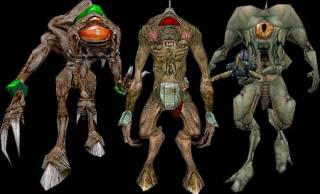
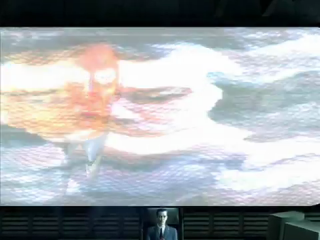
There’s a reason why this scene is so crucial, and it’s that it poses so many questions and neglects to answer all of them. The G-Man obviously feels threatened by the Vortigaunts -- “I had to wait until your friends were otherwise occupied” -- but, if he is so powerful, why does he feel threatened? Is Alyx more important to the G-Man’s plan than Freeman himself is? What are the restrictions the G-Man has “agreed to abide by”, and who posed those restrictions? And why does the G-Man say “extract” like the Vortigaunts say “extract”, with reference to the antlion extract? (Actually, in this case, maybe that’s more of a half-hearted joke from Valve.)
And, finally, one that I find perhaps the most disquieting: why does the G-Man pause, and sneer, when he says to Alyx, “When you see your... ‘father’”? Exactly at the moment he says “father” there is a distortion in the music in the background. Perhaps this is just foreshadowing what is fated to happen to Eli. Or, alternatively, and as the G-Man’s body language and sneer would suggest, is there it that there’s something else related to Alyx’s father? We take it on good confidence that Eli is in fact Alyx’s father, but is the story somewhat deeper? We know Valve’s been throwing around ideas as to the G-Man’s origin. In the early development of Half-Life 2, it was even hinted that he was Gordon Freeman’s father. I personally prefer to place little such significance on the G-Man -- he is just a businessman, as his profile once said, albeit a particularly malevolent and omnipotent one. But that does not mean he couldn’t have been hinting at something else.
That’s why, all in all, I revere this particular scene and hold it in high esteem. It’s so loaded, so well acted, so well paced, and so terrifying, that I simply cannot get past it, and my jaw drops every single time I arrive at it.
Where to from here for Half-Life 2: Episode Three?
It’s been some three years since the release of Episode Two, and fans of Half-Life have been clamoring for Episode Three from the moment Episode Two hit. As a conclusion for this discussion about Episode Two, I thought I’d share my ideas of where I’d to see Episode Three go. I cannot speak to the likelihood of one, some, or all of these things happening, but I always find it interesting when people throw their ideas around, so here are some of mine.Unfortunately for Valve, expectations regarding Episode Three have been at fever pitch for some time and this fever pitch shows no signs of abating. People might say that “I’m kind of over it” or “Half-Life isn’t so relevant anymore” or “I just want the game to come out” but we all know that as soon as that first Episode Three trailer hits the mercury is going to shatter the thermometer. In other words, it’ll just take some visuals from the game to set people off again. And rightly so, because the Half-Life franchise is one of the most important and one of the very best video game franchises out there. I’m not so concerned that Valve won’t be able to deliver because they will deliver; I’m more concerned about the fact that Valve’s internal fear of not being able to deliver, if such a thing exists, will hold it back. Valve just needs to get the ideas down on paper, and set itself to a timetable, and get the thing finished. It kind of ties in with that whole question we’ve been debating for a while which is essentially, “What do they have to do?” They have to have something big. That’s what’s expected of them. It is a fact that it’s felt like a tremendously long time since Episode Two, and now people are looking toward Episode Three as if it’s Half-Life 3 (the unfortunate synchronicity of the Three/3 doesn’t help, either). It’s quite an unfair burden to place on Valve, of course, because it never intended for it to be like this. Episode Three is merely an expansion of Half-Life 2, no matter that Half-Life 2 was released the better part of a century ago.
Does Valve have to have some big new gameplay revelation? I certainly don’t think they do. I’m not convinced there’s much more Valve can do at this point. What I want is Valve to show that it’s learned from its mistakes. It recently absorbed a developer (I can’t recall the developer’s name, unfortunately) that was famed for its ability to code good artificial intelligence. That’s a good start. AI has always been a problem in the Half-Life 2 arc, and now is the time to show that those men and women can truly code some blockbuster AI. Also important is having great level design, but indications from Episode Two and franchises like Portal and Left 4 Dead show that Valve has grown tremendously in that respect. So, ultimately, no revelations are needed, but a solid, well polished, well oiled product is.
There’s one major gameplay element I think they need to address: physics puzzles. At this point, physics puzzles are expected in the Half-Life franchise, but to me they seem a little trite. I still find the puzzles to be fun, but I think Episode Two truly did hit the right balance with the puzzles, and I would be a little disappointed to see Valve take a step back from there.
Half-Life 2: Episode Two left a tremendous number of narrative questions wafting out in the ether. There are also some narrative concerns. Consider, for example, that Alyx’s father has just died. Alyx needs to be out of commission for at least half the game. There is no way that Valve can justifiably have her running up and around with Gordon once more, because Alyx has always felt akin to a real person. Anybody that’s had the unfortunate fate to see someone go through the grieving process after losing their father, particularly a female who’s lost her father, will know that it is a very long, arduous, and painful process, and people simply don’t pick up the pieces one minute after the event and go and shoot down more Combine, no matter how angry or outraged they are. As I say, then, Alyx almost needs to be a no-show, as beloved a character as she may be. Theoretically Barney should be somewhere around White Forest, if not sheltering at White Forest proper, and I would be more than happy to see him take over the co-op buddy role.
There have been indications that this will not be the case, however, and that Alyx will play a prominent role (which concerns me), because there has long been chatter about the parts deafness and sign language will have in the game. Both Alyx and Dog know sign language. Apparently they learned it when Alyx was dating a deaf scientist at Kliener’s lab before Gordon came along. I’ve not played a game with such a mechanic, so it could certainly be interesting, putting aside that indication that Alyx will be more involved in this game than she probably should be. It occurs to me that it would be a sure-fire way to communicate with the very mute Dr. Freeman, but Freeman being both deaf and mute would be one hell of a retcon to execute, and I think Valve know better than that. It’s also probably not the direction they want to take the character in, in any event.
Finally, I’d like to touch on the whole Portal/Aperture Science/portal gun/Borealis vibe that Episode Three has going. It seems that most people now expect the Portal gun to feature in Episode Three, and for it to be functional and for it to be one of the player’s weapons. I personally am on thin ice with this proposition. It has yet to be proven to me that it would be a good idea. I am more than accepting of a narrative crossover, but Half-Life and Portal are two very different games with very different gameplay styles, and I don’t really think (nor do I want) the two to be crossed over just because it may seem obligatory. Besides, it would need to be explained how exactly the Portal gun got from the Aperture laboratories and then on the Borealis and then back to Aperture for Portal 2 (unless, of course, there is more than one Portal gun, which, in all probability, there is).
I like many others wait with baited breath for the game to come out. My only interest is to see how this edition of the tale of Gordon Freeman concludes, and I have all confidence in Valve that they will be able to do the Freeman -- do the player -- justice.
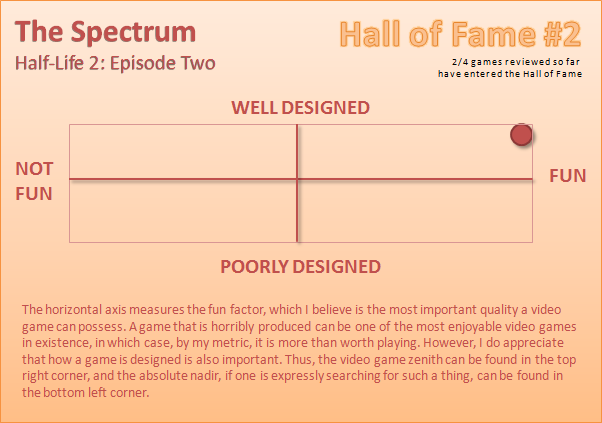
Past articles
Here is a list of the other games I have covered, for posterity’s sake.- Half-Life 2: Episode One - Better than the original, or a lateral shift? (08-17-2010)
- Half-Life 2 - This game is still pretty good (08-13-2010)
- Metal Gear Solid 4 - Why it's nowhere near as good as you think (07-20-2010)
